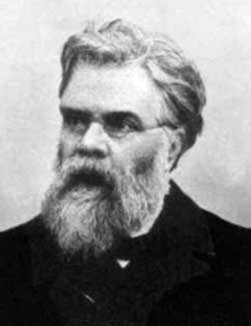

تاريخ الرياضيات

الاعداد و نظريتها

تاريخ التحليل

تار يخ الجبر

الهندسة و التبلوجي


الرياضيات في الحضارات المختلفة

العربية

اليونانية

البابلية

الصينية

المايا

المصرية

الهندية


الرياضيات المتقطعة

المنطق

اسس الرياضيات

فلسفة الرياضيات

مواضيع عامة في المنطق


الجبر

الجبر الخطي

الجبر المجرد

الجبر البولياني

مواضيع عامة في الجبر

الضبابية

نظرية المجموعات

نظرية الزمر

نظرية الحلقات والحقول

نظرية الاعداد

نظرية الفئات

حساب المتجهات

المتتاليات-المتسلسلات

المصفوفات و نظريتها

المثلثات


الهندسة

الهندسة المستوية

الهندسة غير المستوية

مواضيع عامة في الهندسة

التفاضل و التكامل


المعادلات التفاضلية و التكاملية

معادلات تفاضلية

معادلات تكاملية

مواضيع عامة في المعادلات


التحليل

التحليل العددي

التحليل العقدي

التحليل الدالي

مواضيع عامة في التحليل

التحليل الحقيقي

التبلوجيا

نظرية الالعاب

الاحتمالات و الاحصاء

نظرية التحكم

بحوث العمليات

نظرية الكم

الشفرات

الرياضيات التطبيقية

نظريات ومبرهنات


علماء الرياضيات

500AD

500-1499

1000to1499

1500to1599

1600to1649

1650to1699

1700to1749

1750to1779

1780to1799

1800to1819

1820to1829

1830to1839

1840to1849

1850to1859

1860to1864

1865to1869

1870to1874

1875to1879

1880to1884

1885to1889

1890to1894

1895to1899

1900to1904

1905to1909

1910to1914

1915to1919

1920to1924

1925to1929

1930to1939

1940to the present

علماء الرياضيات

الرياضيات في العلوم الاخرى

بحوث و اطاريح جامعية

هل تعلم

طرائق التدريس

الرياضيات العامة

نظرية البيان
Émile Michel Hyacinthe Lemoine
المؤلف:
S L Greitzer
المصدر:
Biography in Dictionary of Scientific Biography
الجزء والصفحة:
...
18-1-2017
720
Died: 21 February 1912 in Paris, France

Émile Lemoine was educated at the École Polytechnique graduating in 1860. He remained there teaching for six years when he retired through ill health.
Changing career he became a civil engineer but worked as an amateur mathematician and musician. His serious interest in music while at École Polytechnique led him to join a chamber orchestra "La Trompette" which was good enough to have Saint-Saëns write music especially for it.
As a civil engineer he rose to the rank of chief inspector and in that capacity he was responsible for the gas supply to Paris. He worked in the gas inspection service from 1886 until 1896.
Lemoine work in mathematics was mainly on geometry. He founded a new study of properties of a triangle in a paper of 1873 where he studied the point of intersection of the symmedians of a triangle. He had been a founder member of the Association Française pour l'Avancement des Sciences and it was at a meeting of the Association in 1873 in Lyon that he presented his work on the symmedians.
A symmedian of a triangle from vertex A is obtained by reflecting the median from A in the bisector of the angle A. He proved that the symmedians are concurrent, the point where they meet now being called the Lemoine point. Among other results on symmedians in Lemoine's 1873 paper is the result that the symmedian from the vertex A cuts the side BC of the triangle in the ratio of the squares of the sides AC and AB. He also proved that if parallels are drawn through the Lemoine point parallel to the three sides of the triangle then the six points lie on a circle, now called the Lemoine circle. Its centre is at the mid-point of the line joining the Lemoine point to the circumcentre of the triangle.
These results are interesting but Lemoine's next venture failed to interest many mathematicians. He produced a classification of geometry according to five operations:-
- placing a compass end on a given point
- placing a compass end on a given line
- drawing a circle with the compass so placed
- placing a straight edge on a given line
- drawing a line with the straight edge so placed.
Lemoine then classified the "simplicity" of a construction according to how many times these five operations had to be used. As an example of the types of results that he obtained was to study the problem of constructing a circle tangent to three given circles: the Apollonius problem. The usual construction required over 400 of Lemoine's operations but he was able to reduce the number to 199.
He presented these results to the meeting of the Association Française pour l'Avancement des Sciences in 1888 at Oran in Algeria. One would have to say that these results were not thought to be particularly interesting by mathematicians at the meeting and there has been a similar lack of interest ever since.
It is perhaps worth asking what is interesting in mathematics. Why are these results of Lemoine not found interesting? All I [EFR] can add is that I agree with the mathematicians of the time who preferred a construction with a large number of easily understood steps to a shorter one with sophisticated, rather obscure, steps. Let me add that I do find Lemoine's results on symmedians of a triangle to be very interesting and beautiful!
Lemoine gave up active mathematical research in 1895 but continued to support the subject. He had helped to found a mathematical journal in 1894 and he became its first editor, a role he held for many years.
- S L Greitzer, Biography in Dictionary of Scientific Biography (New York 1970-1990).
http://www.encyclopedia.com/doc/1G2-2830902548.html
Articles:
- J L Coolidge, A history of geometrical methods (Oxford, 1940), 58.
- D E Smith, Biography. Emile-Michel-Hyacinthe Lemoine, Amer. Math. Monthly 3 (1896), 29-33.
- K Weisse and P Schreiber, Zur Geschichte des Lemoineschen Punktes, Beiträge zur Geschichte, Philosophie und Methodologie der Mathematik II, Wiss. Z. Greifswald. Ernst-Moritz-Arndt-Univ. Math.-Natur. Reihe 38 (4) (1989), 73-74.
 الاكثر قراءة في 1840to1849
الاكثر قراءة في 1840to1849
 اخر الاخبار
اخر الاخبار
اخبار العتبة العباسية المقدسة

الآخبار الصحية















 قسم الشؤون الفكرية يصدر كتاباً يوثق تاريخ السدانة في العتبة العباسية المقدسة
قسم الشؤون الفكرية يصدر كتاباً يوثق تاريخ السدانة في العتبة العباسية المقدسة "المهمة".. إصدار قصصي يوثّق القصص الفائزة في مسابقة فتوى الدفاع المقدسة للقصة القصيرة
"المهمة".. إصدار قصصي يوثّق القصص الفائزة في مسابقة فتوى الدفاع المقدسة للقصة القصيرة (نوافذ).. إصدار أدبي يوثق القصص الفائزة في مسابقة الإمام العسكري (عليه السلام)
(نوافذ).. إصدار أدبي يوثق القصص الفائزة في مسابقة الإمام العسكري (عليه السلام)


















